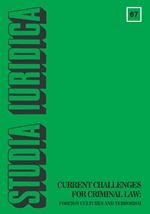KONSTANTYŃSKIE OGRANICZENIE ROZWODÓW: WOLNOŚĆ MAŁŻEŃSTW PRZEBITA SZPILKĄ DO WŁOSÓW
THE CONSTANTINE DIVORCES LIMITATIONS: FREEDOM OF MARRIAGES PIERCED WITH A HAIR-PIN
Author(s): Jakub UrbanikSubject(s): Law, Constitution, Jurisprudence
Published by: Wydawnictwa Uniwersytetu Warszawskiego
Keywords: prawo rodzinne; prawo małżeńskie; reformy konstantyńskie; prawo rzymskie
Summary/Abstract: Since the last decade of the past century the legislators as well as courts and public administration of many European and North American countries have started relaxing the traditional discipline of family law and, in particular, of matrimonial law, generally aiming at expanding legal protection over factual relations (common law marriages) and at facilitating dissolutions of legally contracted marriages. This remarkable process has caused heated discussions not only because of its social importance and controversiality, but also from the purely theoretic point of view: it inevitably leads to a redefinition of the traditionally sanctioned vision of marriage. It may, thus, seem interesting, both for a legal historian and theoretician, to re-examine the particular historical moment, when this development was proceeding in the reversed direction, i.e. when the Romans abandoned the loose construction of marriage based on affectio maritalis in favour of the pattern of initial consent. At the dawn of Middle-Ages this latter model, through the canon order, was to become the only acceptable variant of marital union. The Constatine’s regulation, CTh. 3.16.1, which goal was to limit divorces at will, is generally regarded the starting point of this historical development, as one of the principal arguments for theory of constant marital consent was the total informality and liberty of divorces (cf. Volterra). The paper presents an exegesis of the fragment in question and its confrontation with the so-called “barbaric” Interpretation, as well as possible, but far from clear, traces of its application in the legal practice of the papyri; a few new interpretations of the papyri in question are offered. It is argued, contra Volterra, that Constantine’s Edict does not radically and finally change the legal and dogmatic structure of the Roman marriage. Even though it criminalised unilateral divorces, it did not proclaim them as void; one has also to bear in mind that the affectio maritalis doctrine in the classical times remained most probably a purely juridical concept, and that jurists struggled with its application to the social practice. It is also peculiar that the original sanction imposed on male divorcees does not seem too severe: many marriage instruments foresee a loss of the dowry in total by the husband in case of a repudial by him induced. The same situation could be observed about divorce deeds being in fact dowry receipts issued by the former wives to their husbands. Finally, the possible motives and genesis of the Constantine’s revolution are discussed. In this part of the paper, the one time suggested prevalent influence of Christianity on the reform is dismissed, the chief argument being incongruence and discrepancies between early Churches doctrine on divorce and the Constantine’s legislation. It is argued that equally revolutionary in Constantine’s normative is the introduction of inequality of sexes. The impu
Journal: Studia Iuridica
- Issue Year: 2006
- Issue No: 45
- Page Range: 255-268
- Page Count: 14
- Language: Polish

